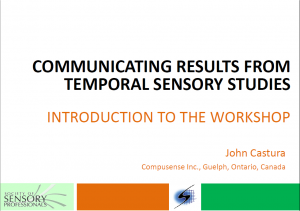Communicating Results from Temporal Sensory Studies
 Various methods are available for characterizing the dynamic sensory properties of foods, beverages, and other products. Conventional temporal methods include time-intensity and discrete evaluation of attributes at specified time points. Time-intensity allows the intensity of one, or at most two, attributes to be tracked continuously with time. The conventional approaches can be applied to capture either intensity or hedonic responses.In recent years new temporal methods have been proposed, such as Temporal Dominance of Sensations (Pineau et al., 2004), Temporal Order of Sensations (Pecore et al., 2011), and Multiple Attribute Time Intensity (Kuesten et al., 2011), sometimes referred to as TDS, TOS, and MATI, respectively. Each method provides slightly different information than could be obtained from other temporal methods.
Various methods are available for characterizing the dynamic sensory properties of foods, beverages, and other products. Conventional temporal methods include time-intensity and discrete evaluation of attributes at specified time points. Time-intensity allows the intensity of one, or at most two, attributes to be tracked continuously with time. The conventional approaches can be applied to capture either intensity or hedonic responses.In recent years new temporal methods have been proposed, such as Temporal Dominance of Sensations (Pineau et al., 2004), Temporal Order of Sensations (Pecore et al., 2011), and Multiple Attribute Time Intensity (Kuesten et al., 2011), sometimes referred to as TDS, TOS, and MATI, respectively. Each method provides slightly different information than could be obtained from other temporal methods.
A temporal study is a non-trivial investment of time and money; if such as study is undertaken it should yield meaningful information. The study objectives must be well understood, and the method selected should be capable of answering the research question at hand. One of the major challenges, even with a well-executed study, involves communication of results. Decisions might be inappropriate if based on poorly communicated research findings.
The workshop speakers will share their observations and insights based on experiences with communicating results from temporal studies to higher management and project teams.
John Castura will chair the workshop, and will introduce some considerations for presenting results from temporal methods.
Tom Carr has industry experience working on high-intensity sweeteners and consulting for major consumer packaged goods companies, and will share his experiences with communicating time intensity results.
Amanda Warnock is Sensory Project Manager at Givaudan Flavors Corp. in Cincinnati. She will offer recommendations for effectively communicating TDS results based on her experiences.
Suzanne Pecore introduced the TOS method at the 9th Pangborn Symposium in Toronto last year. At this workshop she will present slides containing insights related to communication of TOS results.
![]()
Castura, J. C., Carr, B. T., Warnock, A., & Pecore, S. (2012). Communicating results from temporal sensory studies. 2012 Conference of the Society of Sensory Professionals. 10-12 October. Jersey City, NJ, USA. (Workshop).